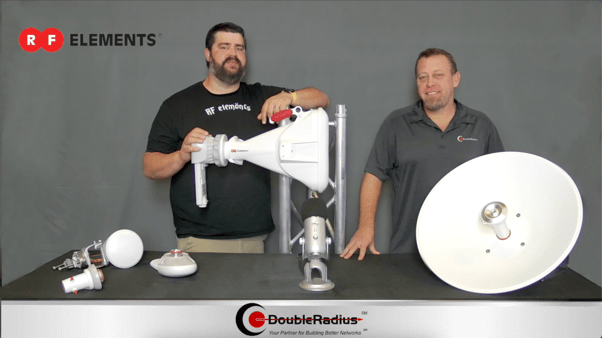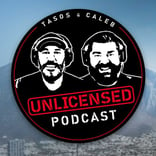This episode on the Solution Series with RF Elements, and Caleb Knauer, redefining industry standards in three main areas: noise mitigation, RF performance, and scalability for WISP networks.

Hosted by Jeff Holdenrid and joined by Caleb Knauer with RF Elements.
RF Elements is an antenna manufacturer, and we know there’s a lot of different options out there, so what makes them different?
The mission of RF Elements is to redefine industry standards in 3 main areas; noise mitigation, RF performance, and scalability for wisp wireless networks.
In talking about noise mitigation, where does RF Elements’ technology take you?
As we all know noise is bad. One of the major sources of noise is wisps' use of a traditional patch of ray sectors. The traditional patch of ray that we have known and dealt with over the years (90°, 120°, tall, wide, etc) carries issues. The problem with these solutions is that they are very noisy, and they have side lobes and back lobes. You have the main beam for your host and where your main coverage area is. But you have these side lobes and back lobes not only sending out noise and polluting the air space, but you’re also receiving noise from those locations. Whether it is another AP on the tower, maybe it’s other locations, or wherever the noise is coming from. It is very bad for performance because you’re picking up all this external noise and it’s messing up your SNRs, your data rate, and so on. The way we fight that is with the horn antenna technology. What we’ve done in this horn technology is completely remove the side lobes and the back lobes, and focus all the energy on the main beam coming out of this antenna. That beam efficiency, the measurement of how much energy is coming out, is high on horn antennas, and it is really important to get the performance that you want.
There are other factors at play as well, kind of play into the art performance side of things. Most people focus on the horns because of the sidelobe and the back lobe reduction, but there’s so much more to that. With the horn technology, you’re able to keep your patterns very stable as you move across the whole frequency band. You’re keeping a polarization pattern stable between your horizontal and vertical so you don’t get all these goofy chain mismatch errors. You’re keeping your gain flat across a frequency range, which is important. Most folks that are using patch array sectors don’t even know that as they change channels patterns are moving around a little bit differently shaped, their gain might be going up and down. It’s kind of a mess. Horn technology allows you to fix those issues and get the most efficient performance you can get out of your antenna.
There are other things we do as well to improve the RF performance that also plays in the scalability. The biggest part of that is using our twist port and twist port adaptor ecosystem. The twist port adaptor uses our twist port, which is how it locks into our antenna, to convert an RF connector on the radio to a waveguide. It is really easy to use. All you do to put it together is click it in, rotate, lock it in, now you’re done. You have attached your radio to your antenna with virtually 0 RF loss, no goofy pigtails to worry about, no weather proving. You don't have to worry about birds sitting on them, or eating them. This improves RF performance, makes for a quick and easy install, and gives you a lot of flexibility. Maybe your migrating networks, for instance, the twistport come into the migration and scalability of things. For example; if you are moving from one network technology to the other (one vendor to the other) and you’re using Cambium going 2000s over to the 3000s, 3000 to 4000, maybe you’re using Ubiquiti and you’re going from prism AC to LTE, maybe you're using Mimosa and your going to their new AX series. You don’t have to replace your whole antenna and your whole ecosystem on the tower up there to move to these new technologies. All you need to do is get your radio, pop it into the same port adapter, or a new one if required, lock it in, pull the old one off, click the new one on and now you’re off to the races! It makes for a really quick and easy migration path and plays a lot into the scalability of deploying different horns and different antennas on the tower.
Mentioning scalability so what are some of the other options you do offer in your products?
With the horns we have 11 or 12 different sizes or versions of iterations, we have a couple of main product categories. The first one is our symmetrical horn. A symmetrical horn has a pattern in the azimuth and elevation that are symmetrical, meaning the same. Then you have the Asymmetrical horns where the azimuth is wide but the elevation is relatively narrow. Sort of similar to the sector style but with all the benefits I mentioned before, this is a really popular product for us. DoubleRadius sells a ton of them.
Isn’t this one RF Elements just won an award for?
Yes, it is. RF Elements won Wispa Product of the Year for the asymmetric horns for the last 3 years, in 2019, 2020, and we just found out in Vegas this year we won again. We are super proud of this, we’re super humbled. Thanks to everyone who put in the work, thanks to everyone who voted for our product and continues to use it, we wouldn’t be here if it weren’t for you guys.
We also have other products; we have our ultra dishes that also support the twistport. We have a variety of other products like starter horns, our starter dishes, our low-cost entry point to use our ecosystem. We have our array sectors, we do offer some sectors, but they have been optimized to be the best performance you can get out of a sector. You’re not getting this from the competition with our back shield technology and our beam balancing, it’s a great value and is super effective in areas where you would use a sector, maybe really rural areas that are spread out to cover long distances. We also have some crazy options such as the Ultra Horn, traditionally it's used for doing point-to-point, but we are seeing more uses now for businesses doing high-density sectors. This bad boy has a 15° spread on the main beam, which means if you put up 10 of them, you're covering 150° of areas. What that means is you can work with really high dense sectors, load them up well. The higher gain gives you a lot more ability to do further distances and cut out all that noise. We got a lot of options, a lot of different ways to deploy things. You can mix and match things however you want. For example, you have a tower with a lot of density to the north but not much on the back, you could run 20° or 30° sectors up the front, and maybe in the back, you put up a ray sector. If you need a little bit more coverage you can throw up a 90 or a 60. A lot of different options available and many different ways to swing a hammer, we’re just giving you more tools in the toolbox to give you the best deployment options that you’ve got available.
Besides actually reaching out to your DoubleRadius sales rep to learn more about this, what are the resources you guys have available? The first person to reach out to would-be a rep at DoubleRadius, a great partner for us and we have been working together with your company for years. They are all well trained and know-how products work. If you have direct questions and you wanna talk to us about it you can find us on the website, RFElements.com. Check out our link calculator there, a very powerful tool that will help you determine what horn you want to deploy, what signal levels you should expect, and the coverage you should expect. For some more resources, we have a YouTube channel with our Inside Wireless which is where we do a lot of sort of general wireless training. We have a podcast now where Tasos and I talk about all sorts of different facets of the wisp industry, what solutions are available, and you can reach out to me directly at caleb@rfelements.com. That will take you straight to me and I’m more than happy to answer any questions you may have.
These products are all available at DoubleRadius, we’re stocking these at all 3 of our warehouse locations across North America. But like we said, if you want to reach out to your sales rep or reach out to RF Elements directly, ask questions. Hopefully, with this segment, you all have learned something new. Thank you for enjoying this segment, thank you Caleb and RF Elements for joining us. Until next time, have a wonderful day.
